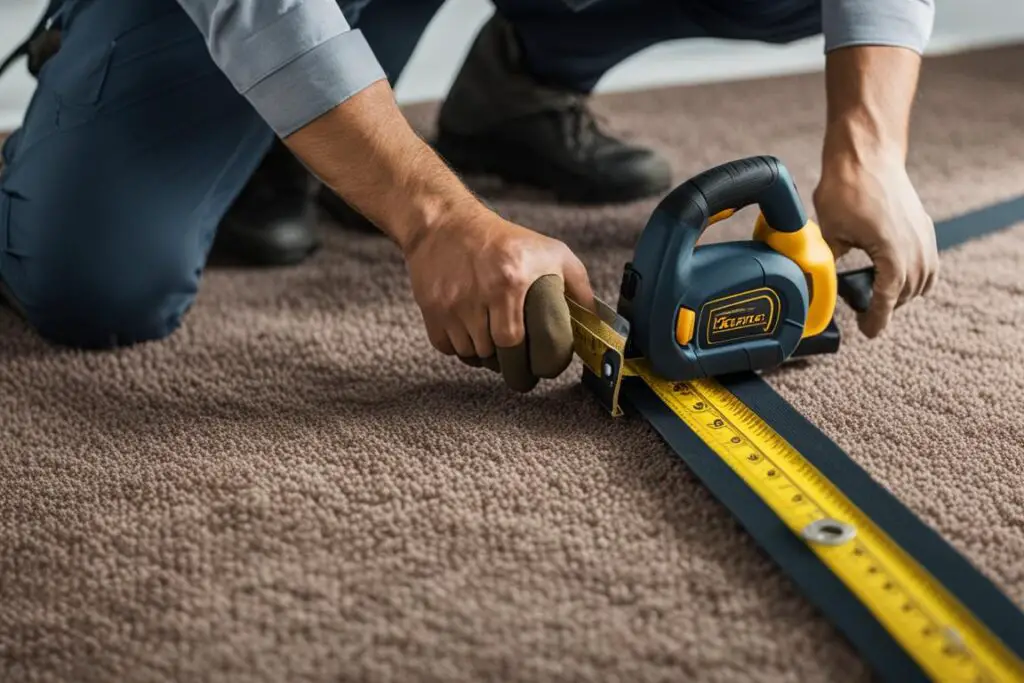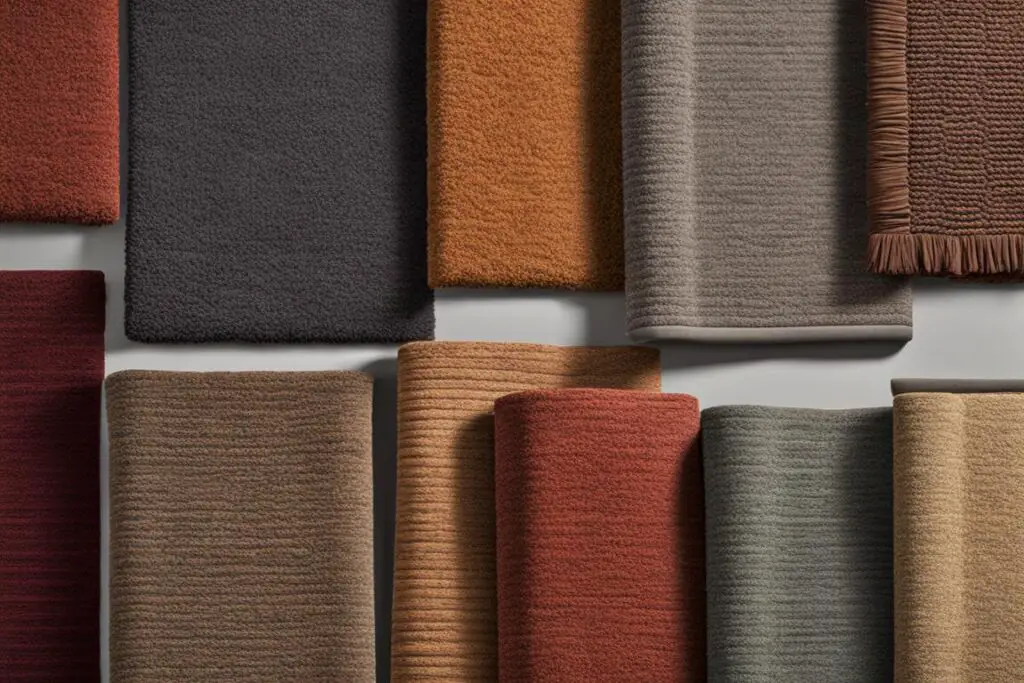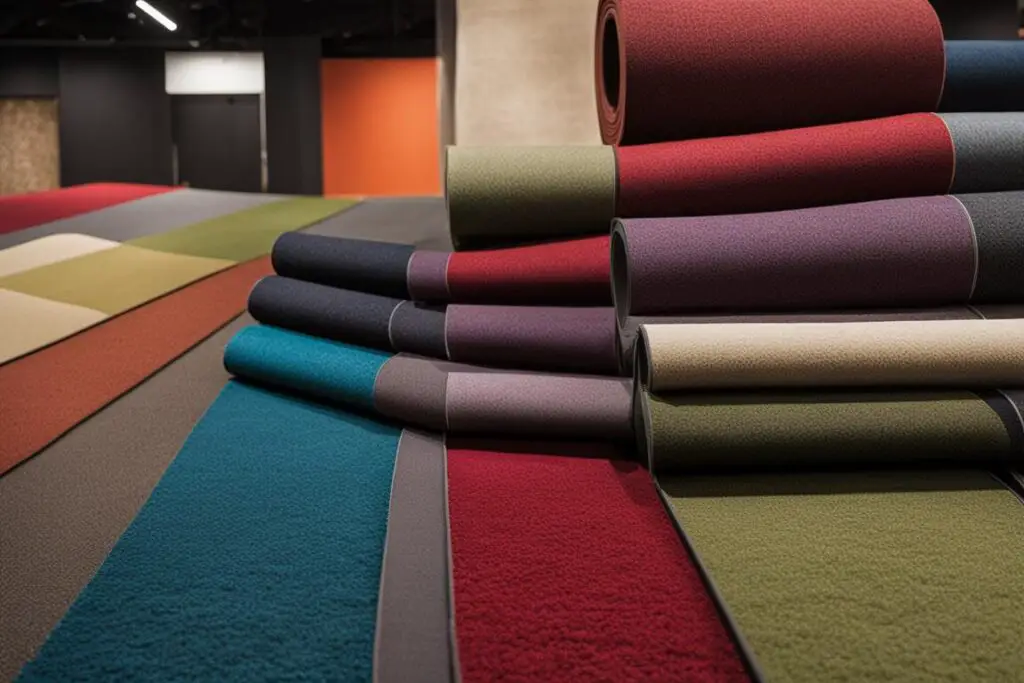When it comes to carpets, one important factor to consider is the width of the carpet rolls. Understanding standard carpet roll sizes, dimensions, and widths can help you make informed decisions for your flooring needs.
Wall-to-wall carpeting is commonly available in rolls measuring around 12 feet in width. However, it’s essential to note that the width may vary slightly depending on the manufacturer. This standard size ensures that many rooms or areas can be covered seamlessly, providing a uniform and aesthetically pleasing finish.
It’s worth mentioning that carpets manufactured in other countries often adhere to a different standard width of four meters, which is equivalent to approximately 13 feet 2 inches. This variation may be a crucial aspect to consider if you are sourcing carpets internationally or have specific dimension requirements.
For commercial spaces, commercial-grade carpeting is often available in narrower widths, around six feet. This narrower width caters to the specific requirements of commercial spaces, ensuring a professional and practical flooring solution.
Key Takeaways
- Standard carpet roll widths for wall-to-wall carpeting are around 12 feet, but it can vary by manufacturer.
- Carpets manufactured in other countries may have a standard width of four meters, approximately 13 feet 2 inches.
- Commercial-grade carpeting for commercial spaces generally comes in narrower widths, around six feet.
Carpet Installation and Expertise
When it comes to carpet installation, it’s important to trust the professionals. While DIY projects may be enticing, carpet installation is a complex task that requires precision and expertise. Hiring professional installers ensures that your carpets are installed correctly for a seamless and visually appealing finish.
Professional carpet installers have the knowledge and experience to measure your room accurately, determine the best carpet width and direction, and minimize waste. Their expertise ensures that your carpet is properly installed, enhancing the durability and lifespan of your flooring investment.
One of the advantages of working with expert installers is their ability to anticipate and address potential challenges. They understand the nuances of carpentry and can navigate floor imperfections, transitions, and other obstacles to create a flawless result.
During the installation process, it’s also important to consider potential shortages or mistakes. By adding an extra 10 to 20 percent of carpet material, professional installers account for any unexpected issues that may arise. This precautionary measure ensures that they have enough material to complete the job without delays or the need for additional orders.

| Benefits of Professional Carpet Installation | DIY Carpet Installation Challenges |
|---|---|
|
|
Standard Sizes for Area Rugs
When it comes to styling your living spaces or dining areas, selecting the right area rug size is crucial for achieving a balanced and aesthetically pleasing look. In this section, we will explore the standard, common dimensions of area rugs that are widely available in the market.
Standard Sizes for Living Rooms and Dining Areas
For larger rooms like living areas and dining spaces, the following sizes are commonly preferred:
| Area Rug Size | Dimensions (feet) |
|---|---|
| 1. 5 x 8 feet | 48″ x 96″ |
| 2. 6 x 9 feet | 72″ x 108″ |
| 3. 8 x 10 feet | 96″ x 120″ |
These sizes provide ample coverage for larger areas and create a well-defined space within the room. With plenty of room to accommodate furniture, these rugs can anchor the seating arrangement and add warmth to the overall ambiance.
Standard Sizes for Larger Living Rooms and Other Spaces
For more spacious living rooms or larger areas within your home, the following standard sizes are commonly found:
| Area Rug Size | Dimensions (feet) |
|---|---|
| 1. 8 x 10 feet | 96″ x 120″ |
| 2. 10 x 12 feet | 120″ x 144″ |
| 3. 10 x 14 feet | 120″ x 168″ |
| 4. 12 x 15 feet | 144″ x 180″ |
These larger sizes are perfect for defining specific areas within larger rooms or expansive floor plans. The generous dimensions allow you to create a grand focal point while maintaining visual harmony.
Standard Sizes for Smaller Spaces
For smaller areas like entryways or bathrooms, compact area rugs with the following dimensions are commonly used:
| Area Rug Size | Dimensions (feet) |
|---|---|
| 1. 3 x 5 feet | 36″ x 60″ |
| 2. 4 x 6 feet | 48″ x 72″ |
These petite rugs are perfect for adding a touch of style and functionality to smaller spaces, providing comfort underfoot and protecting floors from wear and tear.
Standard Sizes for Hallway Runners
In narrow spaces like hallways, hallway runners with the following dimensions are commonly used:
| Runner Size | Dimensions (feet) |
|---|---|
| 1. 2 x 7 feet | 24″ x 84″ |
| 2. 2 x 8 feet | 24″ x 96″ |
These elongated rugs are designed to fit hallways perfectly, creating an inviting and stylish pathway.

Now that we have explored the standard sizes for area rugs, you can confidently choose the ideal dimensions that will complement your living spaces and enhance the overall aesthetic appeal of your home.
Custom Carpet Solutions
When it comes to carpeting, there are options beyond the standard sizes. Many brands offer less commonly found custom carpet sizes to cater to unique room dimensions. This means that homeowners have the flexibility to choose a carpet that fits their space perfectly.
Customization allows for endless styles and design possibilities. Whether you prefer a plush, luxurious carpet or a sleek and modern one, custom carpet options ensure that you can find the perfect fit for your home.
With custom carpet sizes, you can transform any room into a personalized oasis. Whether it’s a small nook or a large open space, customized carpets can be tailored to your exact measurements, ensuring a perfect fit and stunning visual impact.
Don’t settle for a carpet that doesn’t quite fit. Explore the world of custom carpet options and create a space that reflects your unique style and personality.

“Customization is the key to truly elevating your space and making it your own.”
Considerations for Choosing Flooring
When it comes to selecting the perfect flooring for your home, there are several important factors to consider. The choices you make will not only impact the overall look and feel of your space but also affect your budget and long-term satisfaction. Here are a few essential considerations to keep in mind:
1. Lifespan and Practicality
Before making any flooring decisions, think about how long you expect the flooring to last and how practical it is for your specific needs. For high-traffic areas, opt for durable materials like hardwood or tile that can withstand daily wear and tear. In areas prone to moisture, such as bathrooms or kitchens, consider waterproof options like vinyl or ceramic tiles.
2. Budget-Friendly Options
While it may be tempting to choose the cheapest flooring option, it’s essential to think long-term. Investing in higher-quality materials may save you money in the future by minimizing the need for repairs or replacements. Look for budget-friendly flooring materials that offer a good balance between cost and durability, such as laminate or engineered hardwood.
3. Underlay Importance
Don’t overlook the importance of underlay when it comes to flooring installation. A good underlay provides insulation, reduces noise, and acts as a moisture barrier, protecting your flooring from damage. Investing in quality underlay will not only improve the comfort and performance of your floors but also extend their lifespan.
4. Seek Expert Advice
With so many flooring options available, it can be overwhelming to make the right choice. That’s why it’s always a good idea to seek expert advice from professionals in the flooring industry. They can provide valuable insights, recommend suitable materials based on your needs and budget, and guide you through the decision-making process. Their expertise will ensure that you make an informed flooring decision that you’ll be happy with for years to come.
<!–
| Pros | Cons |
|---|---|
| Highly durable | May be more expensive |
| Wide range of design options | Requires professional installation |
| Easy to clean and maintain | Not suitable for areas prone to moisture |
–>
Conclusion
When it comes to flooring solutions and carpet options, Flooring America is your go-to destination. They offer a wide range of carpet options, from standard measurements to customized designs, ensuring that you find the perfect fit for your space.
What sets Flooring America apart is their expert guidance. Their team of flooring professionals is equipped with the knowledge and experience to assist you in bringing your flooring visions to life. Whether you need help selecting the right carpet style, determining the right measurements, or making informed decisions based on your budget and lifestyle, their experts will be there every step of the way.
With Flooring America, you can trust that you’re in good hands. Their commitment to customer satisfaction and their dedication to providing top-notch products and services make them a reliable choice for all your flooring needs. Experience the difference of expert guidance and explore their extensive carpet options today!
FAQ
What is the standard width of carpet rolls?
Wall-to-wall carpeting is commonly available in rolls measuring around 12 feet in width, though the width may vary by manufacturer.
Are there different carpet roll widths in other countries?
Yes, carpets manufactured in other countries often adhere to a different standard width of four meters, equivalent to about 13 feet 2 inches.
What is the width of commercial carpet rolls?
Commercial-grade carpeting is often available in narrower widths, around six feet, to cater to the specific requirements of commercial spaces.
Is DIY carpet installation recommended?
DIY carpet installation is generally not recommended due to the complexities and need for precision. It is best to hire professional installers.
Why should I hire professional installers?
Professional installers have the expertise to measure the room, determine the best carpet width and direction, minimize waste, and ensure a visually appealing finish.
How much extra carpet material should I buy?
It is important to add an extra 10 to 20 percent of carpet material for potential shortage during the installation process.
What are some standard sizes for living rooms or dining areas?
Standard sizes for living rooms or dining areas include 5 x 8 feet, 6 x 9 feet, and 8 x 10 feet.
What are the typical sizes for larger living rooms and other spaces?
Larger living rooms and other spaces may have typical sizes of 8 x 10 feet, 10 x 12 feet, 10 x 14 feet, or 12 x 15 feet.
What sizes are commonly used for smaller spaces?
Smaller spaces like entryways or bathroom areas may have sizes such as 3 x 5 feet or 4 x 6 feet.
What sizes are hallway runners typically available in?
Hallway runners often come in sizes like 2 x 7 feet or 2 x 8 feet.
Are there carpet size options beyond the standard sizes?
Yes, brands may offer less commonly found sizes, and custom options are also available for carpeting.
Should I consider customization for my carpet?
Customization allows for endless styles and true customization to fit specific room dimensions.
What factors should I consider when choosing flooring?
Consider the desired lifespan of the flooring, balancing the look with practicality. Investing in good underlay is important for insulation and moisture barrier. Seek expert advice from professionals to make informed decisions based on needs, budget, and lifestyle.
Where can I find a wide array of carpet options and expert guidance?
Flooring America offers a wide array of carpet options, from standard measurements to customized designs. Their expert team can assist in bringing flooring visions to life and provide guidance throughout the decision-making process.



